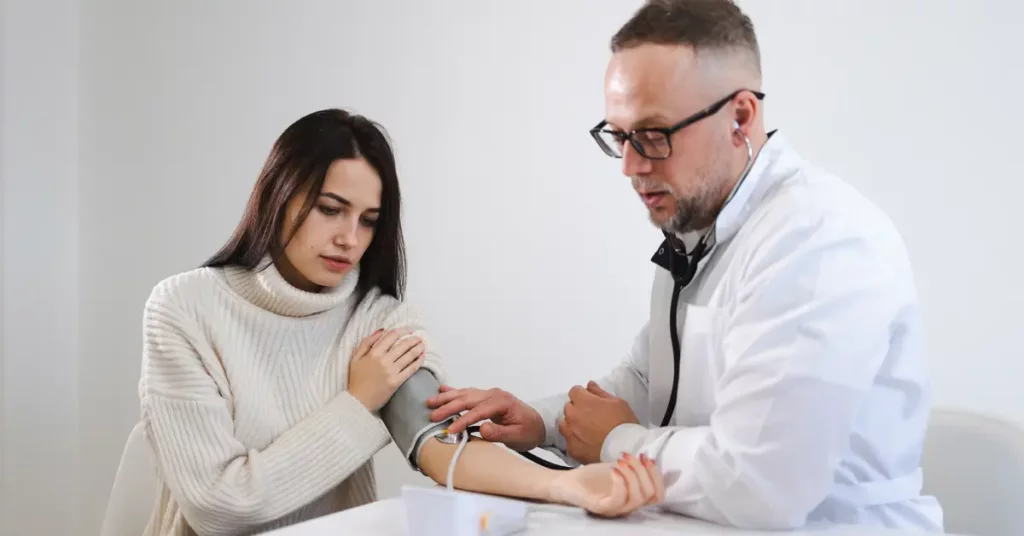Overview
The pressure that the blood puts on the arterial walls as it passes through them is called blood pressure (BP), and a blood pressure that is continuously greater than normal is called hypertension. Systolic and diastolic blood pressure are the two parts of a blood pressure measurement. Systolic blood pressure refers to the pressure in arteries during a heartbeat, whereas diastolic blood pressure refers to the pressure in arteries during a heartbeat’s rest. A healthy person’s blood pressure reading is ≤120/80 millimeters of mercury (mmHg), where the upper and lower readings represent the systolic and diastolic blood pressure, respectively.
Throughout the day, blood pressure varies; it may rise in response to physical activity or stressful situations when the heart may beat more vigorously. Blood pressure is influenced by age as well because as people age, their blood vessel walls grow less elastic and tougher, raising their systolic and diastolic blood pressure readings. The blood pressure reading may be greater if the patient smoked, drank alcohol, took caffeine, or engaged in physical activity within 30 minutes of the blood pressure measurement. Additionally, lowering one’s arms to the side instead of resting them on a table at chest height and crossing one’s legs can raise blood pressure.
Effects of high blood pressure on health
The heart, brain, kidneys, and eyes are among the organs that high blood pressure can harm. The higher the blood pressure, the higher the chance of developing health problems like cardiovascular diseases, myocardial infarction, and stroke. This is because high blood pressure can cause arteries to become less elastic, which reduces blood and oxygen flow to the heart, resulting in heart disease, angina, chest pain, and heart failure.
Elevated blood pressure has the potential to rupture or obstruct the arteries supplying the brain with blood and oxygen, leading to the death of brain cells, stroke, and related impairments in speech, movement, and other fundamental functions, as well as death. High blood pressure is associated with declining cognitive function and dementia in later life, particularly in midlife. In addition, hypertension can cause decreased libido in women, renal problems, erectile dysfunction in men, and vision loss.
Causes and risk factors for hypertension
Primary or essential hypertension and secondary hypertension are two different categories for hypertension. When there is no recognized etiology for hypertension, it is referred to as primary hypertension. This disease causes the body’s smallest arteries to narrow, which increases the heart’s workload in pumping blood to far-off organs and limbs and elevates blood pressure.
Five percent of instances of hypertension are found to have essential hypertension. This kind of hypertension is most frequently linked to age and bad behaviors, such not exercising. Most often, the usage of specific medications or medical conditions such renal or hormone abnormalities cause secondary hypertension.
Risk factors related to high blood pressure
Family history: There may be a hereditary component to hypertension, particularly essential hypertension, and it may run in families. Individuals who have first-degree relatives with hypertension are more likely to develop hypertension themselves.
Medical history: Diabetes mellitus, kidney diseases, Cushing’s syndrome, lupus, pheochromocytoma, or adrenal tumors can all be linked to hypertension.
pharmaceuticals: A number of pharmaceuticals, including corticosteroids, oral contraceptives,
antidepressants, non-steroidal anti-inflammatory drugs (NSAIDs), and drugs of abuse like cocaine, methamphetamine, and amphetamine, can raise blood pressure.
Identification and treatment of hypertension
Despite the fact that high blood pressure rarely exhibits warning signs or symptoms, it is known as the “silent killer” because it can lead to falls, lightheadedness when standing for an extended period of time, and shortness of breath after mild physical exercise. By taking blood pressure readings with sphygmomanometers and blood pressure monitors, hypertension can be identified.
Modifications in lifestyle
People can reduce their blood pressure by altering their diets to limit their intake of sodium (salt), quitting smoking, managing their blood sugar, weight, stress, and physical activity (especially aerobic exercises like walking, biking, or swimming for ≥150 minutes per week, or 30 minutes a day, five days a week).
booze
For men to reduce their risk of hypertension, they should limit their daily alcohol intake to two drinks, and for women to no more than one. One ounce of alcohol, five ounces of wine, or twelve ounces of beer is considered a drink. Furthermore, meals like skim or one percent milk, fresh fruits and vegetables, whole-grain pasta and rice, and fresh vegetables are better for hypertensive people because they are lower in fat, sodium, and calories.
Nutrition
The ideal daily allowance of salt for an individual’s diet is less than 1,500 milligrams of sodium. Foods that are heavy in fat and salt, like fatty meats, whole milk dairy products, butter and margarine, fried foods, processed foods, fast food, and salted snacks, should be avoided. For blood pressure readings to stay within the normal range, one can adhere to the DASH diet (dietary methods to control hypertension).
Medications for blood pressure
First-line anti-hypertensive medications include: (i) ACE inhibitors, which stop the production of ANG II; (ii) ANG II receptor blockers (ARBs), which stop ANG II from binding with blood vessel receptors; (iii) calcium channel blockers (CCBs), which stop calcium from entering blood vessel and heart muscles and allow vascular relaxation; and (iv) diuretics, which flush excess sodium from the body and reduce blood volume.






